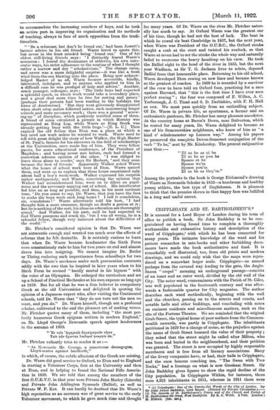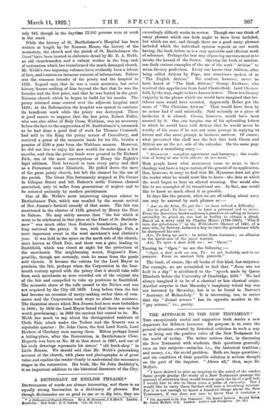CRIPPLEGATE AND ST. BARTHOLOMEW'S.*
IT is unusual for a Lord Mayor of London during his term of office to publish a book. Sir John Baddeley is to be con- gratula,ted on having found time to complete a thoroughly workmanlike and exhaustive history and description of the ward of Cripplegate,' with which he has been connected for many years. His intimate knowledge of the ward and his patient researches in rate-books and other forbidding docu- ments have made the book authoritative and final. It is remarkably well illustrated, too, from old prints and modern drawings, and we could only wish that the maps were repro- duced on a somewhat larger scale. Cripplegate—so named perhaps from the covered way leading to the gate, the Anglo- Saxon " crepel " meaning an underground passage—consists of an inner and an outer ward, divided by the old wall of the City. The outer ward, conterminous with the Parish of St. Giles, was well populated in the fourteenth century and was after- wards a fashionable quarter for City magnates. The author describes each ward methodically, beginning with the wall and the churches, passing on to the streets and courts, and notable halls and other buildings, and concluding with notes on eminent residents and miscellaneous matters, such as the site of the Fortune Theatre. We are reminded that the original Grub Street, the typical home of poor authors from the Common- wealth onwards, was partly in Cripplegate. The inhabitants petitioned in 1829 for a change of name, as the prejudice against the name of Grub Street lessened the value of their property ; they asked that the street might be called after Milton, who was born and buried in the neighbourhood, and their petition was granted. The street is now occupied by highly respectable merchants and is free from all literary associations. Many of the livery companies have, or had, their halls in Cripplegate, and the once famous coaching inn, "The Swan with Two Necks," had a frontage on what is now Gresham Street. Sir John Baddeley gives figures to show the rapid decline of the City population. In Cripplegate Within, for instance, there were 4,921 inhabitants in 1811, whereas in 1911 there were • (1) Cripplegate: One of the Twenty-81s Wards of the City of London. By filr John James Baddeley, Lord Mayor. (Printed for Private circulatIon.)— (2) The Records of St. Bartholomew's Priory and of the Church and Parish of St. Bartholomew the Great, Wed Smithfield. By E. A. Webb. 2 Vols. London U. Milford. [84s. net.1
only 345, though in the daytime 13,105 persons were at work M the ward.
While the history of St. Bartholomew's Hospital has been written at length by Sir Norman Moore, the history of the monastery, the church and the parish of St. Bartholomew the Great2 have been treated in elaborate detail by Mr. E. A. Webb, In old churchwarden and a valiant worker in the long task of restoration which has transformed the much damaged church. Mr. Webb's two imposing volumes have evidently been a labour . of love, and.contain an immense amount of information. Rahere was the common founder of the priory and the hospital in 1123. Legend says that he was a court musician, but sober history knows nothing of him beyond the fact that he was the founder and the first prior, and that he was buried in the great Norman church which he began to build for his monks. The priory retained some control over the adjacent hospital until 1420; at the Reformation the hospital was spared to continue its beneficent work while the priory was destroyed. There is good reason to suppose that the last prior, Robert Faller, who was also abbot of Holy Cross, Waltham, was an accessory before the fact to the suppression of St. Bartholomew's, inasmuch as he had done a good deal of work for Thomas Cromwell, had sold to the King the priory manor of Canonbury, and received a grant of the monastic lands for his life, besides a pension of £200 a year from the Waltham manors. However, he did not live to enjoy his new wealth for more than a few mouths, and then the priory lands were granted to Sir Richard Rich, one of the most unscrupulous of Henry the Eighth's legal advisers. Rich betrayed in turn every party and died as a Protestant under Elizabeth. He pulled down the nave of the great priory church, but left the chancel for the use of the parish. The Great Fire fortunately stopped at Pie Corner In Giltspur Street and left Rahere's noble Norman chancel unscathed, only to suffer from generations of neglect and to be restored patiently by modern parishioners.
One of Mr. Webb's most interesting chapters relates to Bartholomew Fair, which was recalled by the recent revival of Ben Jonson's farcical comedy of that name. The fair was mentioned in the charter of 1133, granted by Henry the First to Rahere. We may safely assume that "the fair which is wont to be celebrated in that place at the Feast of St. Bartholo- mew " was much older than Rahere's foundation, just as it long survived the priory. It was, with Stourbridge Fair, a most important event in the wool merchant's and clothier's year. It was held in the space on the north side of the church, since known as Cloth Fair, and there was a gate, leading to Smithfield, which was closed at night for the protection of the merchants. The neighbouring street, Rugman's Row, possibly, though not certainly, took its name from the goods sold therein. It became the custom for the Lord Mayor to proclaim the fair, perhaps when the Corporation in the four- teenth century agreed with the priory that it should take tolls from such merchants as were crowded out of the original site- of the fair and compelled to take up positions in Smithfield. The monastic share of the tolls passed to the Riches and was not acquired by the City till 1829. Long before then the fair had become an occasion of merry-making rather than of com- merce and the Corporation took steps to abate the nuisance. The theatrical shows which Ben Jonson had seen were forbidden in 1840; by 1850 the Lord Mayor found that there was no fair worth proclaiming ; in 1854 the ancient fair ceased to be. Mr. Webb has much to say about the distinguished residents of Cloth Fair, which under the Tudors and the Stuarts was a reputable quarter : Dr. John Goitre, the first Lord North, Lord Herbert of Cheri:tiny were among them. Milton perhaps found a hiding-place, after the Restoration, in Bartholomew Close. Hogarth was born at No. 58 in that street in 1697, and one of his early drawings represents his sisters' "old frock-shop" in Little Britain. We should add that Mr. Webb's painstaking account of the church, with plans and photographs, is of great value and enables the reader clearly to understand the successive stages in the restoration. His book, like Sir John Baddeley's, is an important addition to the historical literature of the City.



































 Previous page
Previous page